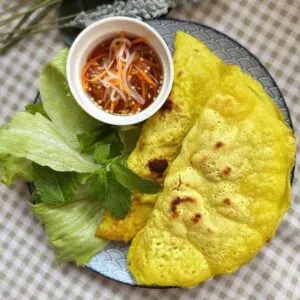Thịt Kho Trứng is one of those soul-soothing dishes every Vietnamese grows up with—pork belly and eggs, slow-braised until tender in a rich, savory sauce. It’s the kind of comfort food that shows up on family tables all across Vietnam, though each region adds its own spin.
Of all the versions out there, the one from Miền Tây—the Mekong Delta—is probably the most beloved. What makes it special? Coconut water. That sweet, mellow touch brings balance to the salty richness and gives the dish its signature Southern charm.
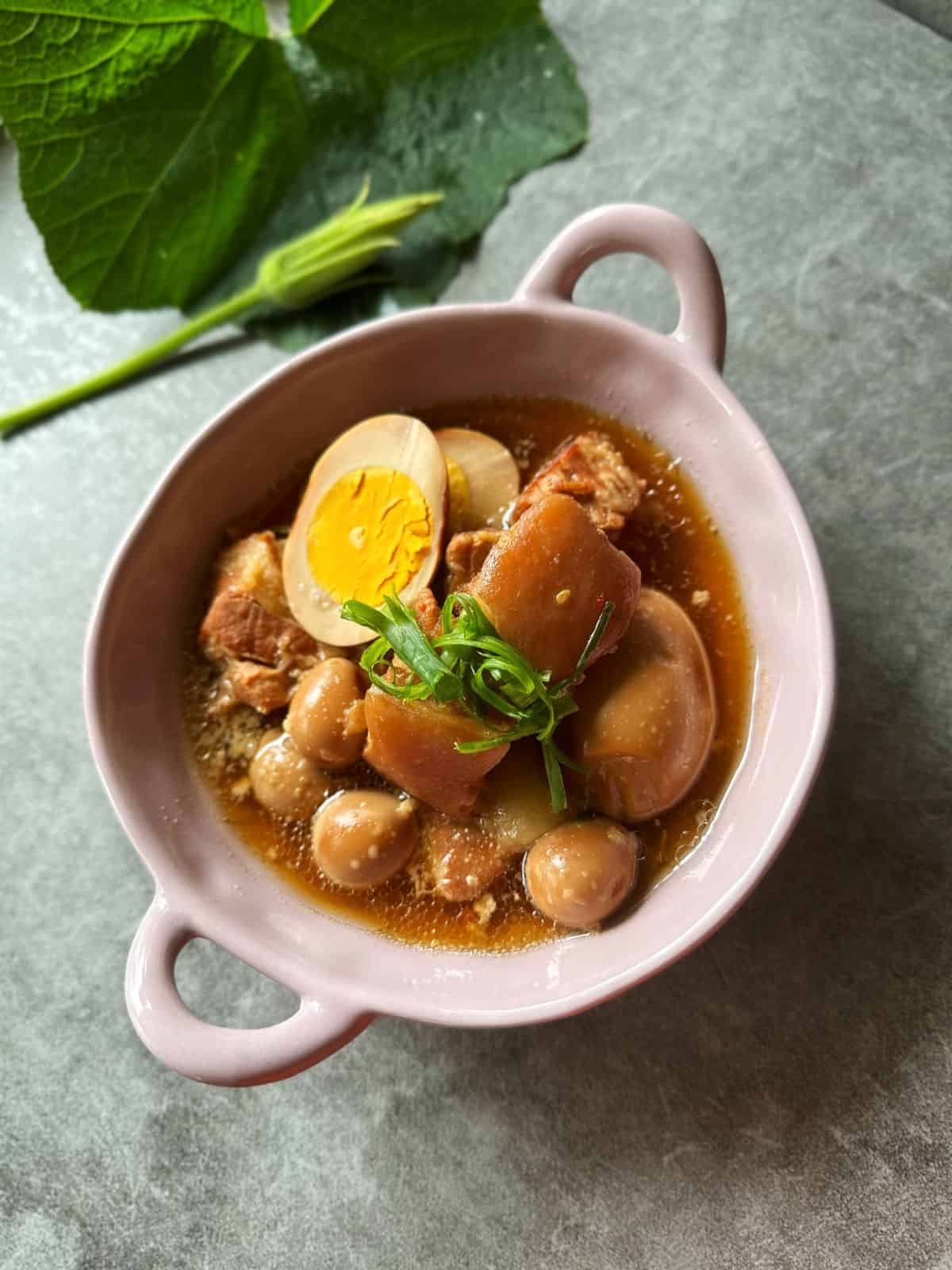
Thịt Kho Trứng: North vs. South
Thịt Kho Trứng, also known as Thịt Kho Tàu or simply Thịt Kho, means “braised pork with eggs.” In Vietnamese cooking, kho is all about slow-cooking—whether it’s braising, stewing, or simmering—so you’ll see that word pop up in many beloved dishes.

I’ve previously shared the Northern-style Thịt Kho Trứng, known for its deep caramel color and more subtle sweetness. One thing that makes it special? The boiled eggs are lightly fried before being added to the pot, giving them a chewy skin that pairs so well with the melt-in-your-mouth pork belly.

Now head down south to Miền Tây—the Mekong Delta—and you’ll find a very different take. Down there, instead of regular water, they use coconut water, and often swap chicken eggs for richer duck eggs.

Coconut water brings a natural sweetness and gives the dish a lovely amber glow, so there’s no need for extra nước màu (Vietnamese caramel sauce).
In Southern Vietnam, Thịt Kho Trứng isn’t just a family staple—it’s the heart of every Tết celebration. You’ll often find it served with Canh Khổ Qua (bitter melon soup) and Bánh Tét (sticky rice cake wrapped in banana leaves). A big pot is usually cooked in advance and enjoyed over several days—a warm, savory symbol of reunion and new beginnings.
Ingredients
- Pork Belly – This is the classic cut for Thịt Kho, loved for its rich flavor and that melt-in-your-mouth texture. If you’re after something a little leaner, pork butt (or shoulder) makes a great substitute without losing too much depth.
- Eggs – In Miền Tây, duck eggs are the gold standard thanks to their richer taste. For this batch, I used a mix of duck and quail eggs for variety, but regular chicken eggs work just fine too—use whatever you have on hand!
- Coconut Water – This is what gives Thịt Kho its signature Southern charm. It adds a mellow sweetness and a golden caramel color that’s hard to beat. Fresh coconut water is ideal, but coconut soda (like Coco Rico) is a fun alternative. No coconut? No worries—just use water with a bit more sugar, or even try cola or Sprite for a modern twist.
- Fish Sauce – The soul of Vietnamese cooking. It’s what brings all the savory, umami depth to the dish, tying everything together.
- Red Chili – A must in Thịt Kho Miền Tây. It adds a pop of color and helps neutralize any strong pork aroma. I like using Thai chili for a real kick, but if you prefer it mild, goat horn chilies or even jalapeños will do the job.
- Seasonings – A touch of chicken powder and sugar rounds out the flavor and gives the sauce that savory-sweet balance we love.
- Aromatics – Shallots and garlic—the dynamic duo that lays the foundation for flavor. Just a quick sauté, and they’ll bring your kitchen to life.
Helpful Tips

- For the best Thịt Kho, use a thick, heavy pot and cook on low heat for about 3 hours. A crockpot works well too. The dish will gradually develop a beautiful caramel hue, with the pork belly becoming soft and tender while the eggs firm up and absorb all the rich flavors.
- Locals often cover the meat with banana or jackfruit leaves while cooking to retain heat and speed up the process. I like to use a large piece of baking paper as a substitute.
- Thịt Kho Trứng pairs wonderfully with steamed jasmine rice and some fermented or pickled veggies like Đồ Chua (pickled carrots and daikon) or Dưa Chua (fermented mustard greens).
More Delicious Dishes from Southern Vietnam

Thịt Kho Trứng (Vietnamese Braised Pork Belly & Eggs)
Equipment
- 1 heavy pot
- 1 large piece of baking paper or banana leaf
Ingredients
- 2 pound pork belly (cut into 5 cm or 2-inch chunks)
- 4 duck eggs (or substitute with 4 chicken eggs or 10 quail eggs)
- 3 cup coconut water (or 3 cups water + 2 tablespoons sugar)
- 2 cup water
- 2 tbsp sugar
- 2 shallots
- 2 cloves garlic
- 1 Thai red chili (or substitute with goat horn chili or jalapeño)
- ¼ cup fish sauce
- ½ tbsp chicken bouillon powder
- ½ lime or lemon
- Cooking oil
Instructions
- Boil the pork belly with a few slices of shallots in water for a few minutes to remove impurities. Wash and rinse the pork thoroughly, then set aside.
- Crush red chili with sugar, minced shallots, and garlic. Mix the pork belly with this mixture and lime juice. Marinate for 30 minutes or, for deeper flavor, overnight in the refrigerator.
- Place the eggs in a pot and fill with water to cover them. Add a splash of vinegar to help with peeling. To center the yolks, gently stir the eggs for the first 3–4 minutes of boiling.Cooking times (from cold water):– Duck eggs: 15 minutes– Chicken eggs: 8 minutes– Quail eggs: 4–5 minutes
- Heat some cooking oil in a pot. Add the marinated pork belly and season with chicken bouillon powder. Stir-fry for about 3 minutes.
- Add coconut water, regular water, and fish sauce to the pot. Bring everything to a boil and skim off any scum. Gently add the boiled eggs to the pot.
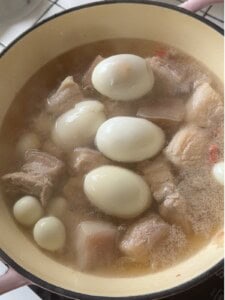
- Cover the surface of the dish with a piece of baking paper or banana leaves to help retain moisture and heat.
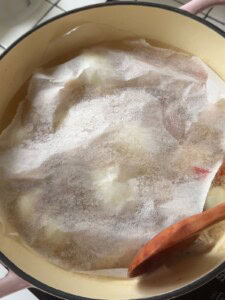
- Lower the heat and simmer on low for 2–3 hours until the meat develops a caramel hue and a melt-in-your-mouth texture.
- Enjoy your Thịt Kho Trứng with steamed rice and pickled vegetables.
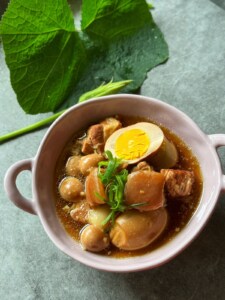
I’d ready introduced the Northern Thịt Kho before. It’s has a darker caramel color, less sweet and the pork belly is cooked with fried boiled eggs which has a fun texture.
In Miền Tây (the Mekong delta version), Thịt Kho Trứng is also called Thịt Kho Rệu, which means the pork belly is cooked for a long time and turn out very soft and tender. The locals often use duck eggs instead of chicken eggs and coconut water instead of regular water. Coconut water gave a dish a natural sweet and caramel color that why we don’t need to add Vietnamese caramel sauce for the amber color.
In Southern Vietnam, Thịt Kho is not only a dish for daily meal but also a must-have for Tết (Vietnamese lunar new years) together with Canh Khổ Qua (bittermelon soup) and Bánh Tét (cylindrical sticky rice cake)


